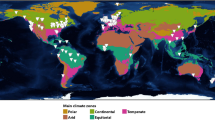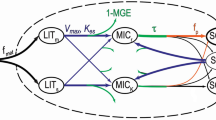Abstract
DyDOC describes soil carbon dynamics, with a focus on dissolved organic carbon (DOC). The model treats the soil as a three-horizon profile, and simulates metabolic carbon transformations, sorption reactions and water transport. Humic substances are partitioned into three fractions, one of which is immobile, while the other two (hydrophilic and hydrophobic) can pass into solution as DOC. DyDOC requires site-specific soil characteristics, and is driven by inputs of litter and water, and air and soil temperatures. The model operates on hourly and daily time steps, and can simulate carbon cycling over both long (hundreds-to-thousands of years) and short (daily) time scales. An important feature of DyDOC is the tracking of 14C, from its entry in litter to its loss as DO14C in drainage water, enabling information about C dynamics to be obtained from both long-term radioactive decay, and the characteristic 14C pulse caused by thermonuclear weapon testing during the 1960s ("bomb carbon"). Parameterisation is performed by assuming a current steady state. Values of a range of variables, including C pools, annual DOC fluxes, and 14C signals, are combined into objective functions for least-squares minimisation. DyDOC has been applied successfully to spruce forest sites at Birkenes (Norway) and Waldstein (Germany), and most of the parameters have similar values at the two sites. The results indicate that the supply of DOC from the surface soil horizon to percolating water depends upon the continual metabolic production of easily leached humic material. In contrast, concentrations and fluxes of DOC in the deeper soil horizons are controlled by sorption processes, involving comparatively large pools of leachable organic matter. Times to reach steady state are calculated to be several hundred years in the organic layer, and hundreds-to-thousands of years in the deeper mineral layers. It is estimated that DOC supplies 89% of the mineral soil carbon at Birkenes, and 73% at Waldstein. The model, parameterised with "steady state" data, simulates short-term variations in DOC concentrations and fluxes, and in DO14C, which are in approximate agreement with observations.
Similar content being viewed by others
References
Arah J.R.M. and Gaunt J.L. 2001. Questionable assumptions in current soil organic matter transformation models. In: Rees R.M., Ball B.C., Campbell C.D. and Watson C.A. (eds), Sustainable Management of Soil Organic Matter. CAB International, Wallingford, pp. 83–89.
Baxter M.S. and Walton A. 1971. Fluctuations of atmospheric 14C concentrations during the past century. Proc. R. Soc. Ser. A. 321: 105–127.
Boutton T.W., Wong W.W., Hachey D.L., Lee L.S., Cabrera M.P. and Klein P.D. 1983. Comparison of quartz and pyrex tubs for combustion of organic samples for stable carbon isotope analysis. Anal. Chem. 55: 1832–1833.
Broecker W.S. and Olson E.A. 1960. Radiocarbon from nuclear tests. II. Future concentrations predicted for this isotope in the global carbon cycles suggest its use in tracer studies. Science 132: 712–721.
Currie W.S. and Aber J.D. 1997. Modeling leaching as a decomposition process in humid montane forests. Ecology 78: 1844–1860.
Donahue D.J. 1990. Radiocarbon analysis by accelerator mass spectrometry. International J. Mass Spectrometry and Ion Processes 143: 235–245.
Easthouse K.B., Mulder J., Christophersen N. and Seip H.M. 1992. Dissolved organic carbon fractions in soil and stream water during variable hydrological conditions at Birkenes, Southern Norway. Water Resour. Res. 28: 1585–1596.
Gaudinski J.B., Trumbore S.E., Davidson E.A. and Zheng S. 2000. Soil carbon cycling in a temperate forest; radiocarbon-based estimates of residence times, sequestration rates and partitioning of fluxes. Biogeochem. 51: 33–69.
Grieve I.C. 1991. A model of dissolved organic carbon concentrations in soil and stream waters. Hydrol. Proc. 5: 301–307.
Guggenberger G. 1992. Eigenschaften und Dynamik gelöster organischer Substanzen (DOM) auf unterschiedlich immissionsbelasteten Fichtenstandorten. Bayreuther Bodenkundliche Berichte, Band 26..
Guggenberger G., Zech W. and Schulten H.-R. 1994. Formation and mobilization pathways of dissolved organic matter: evidence from chemical structural studies of organic matter fractions in acid forest floor solutions. Org. Geochem. 21: 51–66.
Harkness D.D. and Harrison A.F. 1989. The influence of afforestation on upland soils: the use of bomb 14C enrichment as a quantitative tracer for changes in organic status. Radiocarbon 31: 637–643.
Harkness D.D. and Wilson H.W. 1972. Some applications in radiocarbon measurement at the SURRC. In: Proceedings of Eighth International Conference on Radiocarbon Dating. Vol. 1B. Royal Society of New Zealand, p. 102.
Harkness D.D., Harrison A.F. and Bacon P.J. 1986. The temporal distribution of bomb 14C in a forest soil. Radiocarbon 28: 328–337.
van Hees P.A.W., Lundström U.S. and Giesler R. 2000. Low molecular weight organic acids and their Al-complexes in soil solution – composition, distribution and seasonal variation in three podzolized soils. Geoderma 94: 173–200.
Jenkinson D.S. 1963. The turnover of organic matter in soil. In: The use of isotopes in soil organic matter studies. FAO/IAEA Rep Tech Mtg (Volkenrode), Pergamon, Oxford, UK, (pp 187–198).
Jenkinson D.S. 1990. The turnover of organic carbon and nitrogen in soil. Phil. Trans. Roy. Soc. B. 329: 361–368.
Jenkinson D.S., Harkness D.D., Vance E.D., Adams D.E. and Harrison A.F. 1992. Calculating net primary production and annual input of organic matter to soil from the amount and radiocarbon content of soil organic matter. Soil Biol. Biochem. 24: 295–308.
Kaiser K., Guggenberger G., Haumaier L. and Zech W. 2001. Seasonal variations in the chemical composition of dissolved organic carbon in organic forest floor layer leachates of old-growth Scots pine (Pinus sylvestris L.) and European beech (Fagus sylvatica L.) stands in northeastern Bavaria, Germany. Biogeochemistry 55: 103–143.
King A.W., Post W.M. and Wullschleger S.D. 1997. The potential response of terrestrial carbon storage to changes in climate and atmospheric CO2. Weath. Clim. 13: 3–12.
Levin I. and Kromer B. 1997. Twenty years of atmospheric 14CO2 observations at Schauinsland Station, Germany. Radiocarbon 39: 205–218.
Lofts S., Woof C., Tipping E., Clarke N. and Mulder J. 2001a. Modelling pH buffering and aluminium solubility in European forest soils. Eur. J. Soil Sci. 52: 189–204.
Lofts S., Simon B.M., Tipping E. and Woof C. 2001b. Modelling the solid-solution partitioning of organic matter in European forest soils. Eur. J. Soil Sci. 52: 215–226.
Manderscheid B. and Matzner E. 1995. Spatial and temporal Variability of Soil Solution Chemistry and Ion Fluxes through the soil in a mature Norway Spruce (Picea abies (L.) Karst) Stand. Biogeochemistry 30: 99–114.
McDowell W. and Likens G.E. 1988. Origin, composition and flux of dissolved organic carbon in the Hubbard Brook Valley. Ecol. Mon. 58: 177–195.
Michalzik B., Kalbitz K., Park J.-H., Solinger S. and Matzner E. 2001. Fluxes and concentrations of dissolved organic matter – a synthesis for temperate forests. Biogeochem. 52: 173–205.
Michalzik B. and Matzner E. 1999. Dynamics of dissolved organic nitrogen and carbon in a Central European Norway spruce ecosystem. Eur. J. Soil Sci. 50: 579–590.
Moore T.R., Trofymov J.A., Taylor B., Prescott C., Camiré C., Duschene L. et al. 1999. Litter decomposition rates in Canadian forests. Global Change Biol. 5: 75–82.
Mulder J., Gallardo Lancho J.F., Matzner E., Tipping E., Bryant C., Clarke N. et al. 2000. Effects of Natural Climatic Variations on Production and Transport of Dissolved Organic Matter in European Forest Ecosystems. Final Report to the European Commission, Contract ENV4-CT95-0010..
Nash J.C. and Walker-Smith M. 1987. Non-Linear Parameter Estimation, An Integrated System in BASIC. Dekker, New York.
Neff J.C. and Asner G.P. 2001. Dissolved organic carbon in terrestrial ecosystems: synthesis and a model. Ecosystems 4: 29–48.
Nydal R., Louseth K. and Skogseth F.H. 1980. Transfer of bomb 14C to the ocean surface. In: Stuiver M. and Kra R.S. (eds), Int Conf 10th Proc Radiocarbon. Vol. 22., pp. 626–635.
O'Brien B.J. 1984. Soil organic carbon fluxes and turnover rates from radiocarbon enrichments. Soil Biol. Biochem. 16: 115–120.
Parton W.J., Schimel D.S., Cole C.V. and Ojima D.S. 1987. Analysis of factors controlling soil organic levels of grasslands in the Great Plains. Soil Sci. Soc. Am. J. 51: 1173–1179.
Persson H. 1978. Root dynamics in a young Scots pine stand in Central Sweden. Oikos 30: 508–519.
Post W.M., Emanuel W.R., Zinke P.J. and Stangenberger A.G. 1982. Soil carbon pools and world life zones. Nature 298: 156–159.
Qualls R.G. and Haines B.L. 1991. Geochemistry of dissolved organic nutrients in water percolating through a forest ecosystem. Soil Sci. Soc. Am. J. 55: 1112–1123.
Qualls R.G. and Haines B.L. 1992. Biodegradability of dissolved organic nutrients in forest throughfall, soil solution, and stream water. Soil Sci. Soc. Am. J. 56: 578–586.
Qualls R.G., Haines B.L. and Swank W.T. 1991. Fluxes of dissolved organic nutrients and humic substances in a deciduous forest. Ecology 72: 254–266.
Rowell D.L. 1994. Soil Science. Methods and Applications. Longman, Harlow, Essex.
Santore R.C., Driscoll C.T. and Aloi M. 1995. A model of soil organic matter and its function in temperate forest soil development. In: McFee W.W. and Kelly J.M. (eds), Carbon Forms and Functions in Forest Soils. Soil Science Society of America, Inc., Madison, Wisconsin, USA, pp. 275–298.
Schiff L.S., Aravena R., Trumbore S.E., Hinton M.J., Elgood R. and Dillon P.J. 1997. Export of DOC from forested catchments on the Precambrian Shield of Central Ontario: Clues from 13C and 14C. Biogeochem. 36: 43–65.
Schlesinger W.H. 1997. Biogeochemistry. An Analysis of Global Change. 2nd edn. Academic Press, San Diego.
Schulze E.D., Wirth C. and Heimann M. 2000. Managing forests after Kyoto. Science 289: 2058–2059.
Slota P.J., Jull A.J.T., Linick T.W. and Toolin L.J. 1987. Preparation of small samples for 14C accelerator targets by catalytic reduction of CO. Radiocarbon 29: 303–306.
Southon J.R., Caffee M.W., Advise J.C., More T.L., Proctor I.D., Schemata B. et al. 1990. The new LLNL AMS Spectrometer. Nuclear Instruments and Methods in Physics Research B52: 301–305.
Stuiver M. and Polach H.A. 1977. Discussion: Reporting of 14C data. Radiocarbon 19: 355–363.
Taugbol G., Seip H.M., Bishop K. and Grip H. 1994. Hydrochemical modelling of a stream dominated by organic acids and organically bound aluminium. Wat. Air Soil Pollut. 78: 103–139.
Tipping E. and Woof C. 1991. The distribution of humic substances between the solid and aqueous phases of acid organic soils; a description based on humic heterogeneity and charge-dependent sorption equilibria. J. Soil Sci. 42: 437–448.
Trumbore S.E. 1997. Potential responses of soil organic carbon to global environmental change. Proc. Natl. Acad. Sci. 94: 8284–8291.
Trumbore S.E., Vogel J.S. and Southron J.R. 1989. AMS 14C measurements of fractionated organic matter: an approach to deciphering the soil carbon cycle. Radiocarbon 31: 644–654.
Walton A., Ergin M. and Harkness D.D. 1970. Carbon-14 concentrations in the atmosphere and carbon exchange rates. J. Geophys. Res. 75: 3089–3098.
Rights and permissions
About this article
Cite this article
Michalzik, B., Tipping, E., Mulder, J. et al. Modelling the production and transport of dissolved organic carbon in forest soils. Biogeochemistry 66, 241–264 (2003). https://doi.org/10.1023/B:BIOG.0000005329.68861.27
Issue Date:
DOI: https://doi.org/10.1023/B:BIOG.0000005329.68861.27




